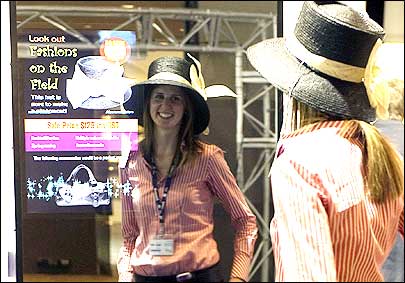Australian shoppers could soon browse for products, choose matching accessories and receive fashion advice, all without leaving a store’s changing room, following the development of an RFID-enabled mirror.
The EPCmagic Mirror reads RFID tags attached to specific retail items and displays product information, such as price, available sizes and color in stock, and the most appropriate accessories, all while shoppers try on clothing. Developed in partnership by NEC Australia and GS1 Australia, the device was unveiled on Oct. 23 at GS1 Australia’s annual Impetus conference.

The EPCmagic Mirror is the first RFID-enabled mirror designed by a single vendor using off-the-shelf technology, says NEC Australia’s product manager, Davide Iacovitti, and could be available in fashion, phone or music stores within months. “We were approached by GS1 Australia six months ago, and asked to jointly develop and fund the mirror because they wanted to show the potential RFID has to retailers,” he says. “NEC Singapore had previously worked on a prototype mirror using LCD screens, but we took what they learnt and developed it further.”
To display the range of information on the mirror, each retail item is fitted with an EPC Gen 2 RFID tag encoded with a unique product code that is transmitted on the ultrahigh-frequency (UHF) band between 918 and 926 MHz. RFID interrogators from Alien Technology, which can read tags up to 2 meters (6.6 feet) away, are then installed behind the mirror.
When the interrogator reads an item’s tag, an LCD projector displays information about that product onto the mirror as a transparent overlay. The system is underpinned by NEC’s WebOTX RFID Manager middleware, which is EPC-compliant.
“We tested the technology on a number of retail items, such as clothing and apparel, which would be the target market for the EPCmagic Mirror,” Iacovitti says. “But we also tested it on mobile phones, allowing features of the phone to be displayed on screen, and CDs, which play the contents when held close to the screen. These applications would most likely be suited to point-of-sale kiosks rather than actual mirrors.”
The goal, Iacovitti notes, was to provide shoppers with the information they require and want, when they need it, rather than bombarding them with advertising messages. And the potential benefits to retailers and shoppers alike are numerous, he adds. The EPCmagic Mirror could provide sales support when salespeople are unavailable, granting customers access to such information as price, product description, availability or how long it would take to get an out-of-stock item in store.
Providing information about matching accessories could also encourage increased sales, Iacovitti says. “The EPCmagic Mirror can provide as much information as the retailer would like,” he explains. “The goal is to provide information and recommendations to increase sales at the point of sale, in much the same way that online retailers do.”
Another exciting benefit, he adds, is data mining and business intelligence. By examining such data as which products were purchased or discarded after being tried on by customers, retailers could obtain important information and intelligence pertaining to buying habits and patterns it would not otherwise be able to capture.
Sue Schmid, GS1 Australia’s general manager of standards development, agrees that the mirror offers some exciting and innovative benefits to retailers and their customers. “This mirror provides yet another improvement to a shopper’s experience, as the amount of information that can be provided is limitless,” she says. “But it will provide practical benefits to retailers by delivering business intelligence on buying habits or inventory.”
Demonstrating RFID’s benefits to retailers was the reason GS1 Australia decided to jointly fund and develop the mirror, Schmid says. “Our goal at GS1 Australia is to generate interest in RFID technology and EPCglobal standards,” she says. “We want to show retailers with no interest in RFID just what can be done with the technology. This mirror goes well beyond traditional supply chain operations, and is sure to stir interest.”
Other companies have developed and demonstrated similar mirrors (see Magicmirror Could Assist Retail Customers, Hong Kong Shoppers Use RFID-enabled Mirror to See What They Want and Metro Group’s Galeria Kaufhof Launches UHF Item-Level Pilot). But NEC Australia says the EPCmagic Mirror has an advantage over other RFID-enabled versions, because it is provided by a single vendor. According to Iacovitti, NEC will be able to offer a complete managed service that includes radio frequency identification, digital signage and broadband connectivity—and because the EPCmagic Mirror is made with off-the-shelf technology, it is available today.
“We could provide the EPCmagic Mirror now for as little as $250 a month,” Iacovitti says. “The novelty of the interactive screens could bring customers back and provide an instant financial benefit, which is important if the retail market continues to decline. But ideally, the mirror will be part of a managed service that includes broadband network, RFID software and hardware and digital signage.”
NEC Australia will begin marketing the EPCmagic Mirror at retail trade shows, Iacovitti adds, as well as to existing customers and GS1 Australia’s partners. “There are a number of channels to market,” he notes, “but our goal is to develop Australia as a center of RFID excellence before promoting the mirror to Asia and around the globe.”

